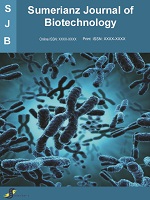Sumerianz Journal of Biotechnology

Online ISSN: 2617-3050
Print ISSN: 2617-3123
Quarterly Published (4 Issues Per Year)
Journal Website: https://www.sumerianz.com/?ic=journal-home&journal=32Archive
Volume 1 Issue 5 (2018)
Antitumor Activity of the Cyclo (L-Phenyl, L-Prolyl) Diketopiperazines Produced By a Newly Isolated Streptomyces Sp. A4.4
Authors : Abdelhalem A. Hamza ; Benjamin R. Clark ; Cormac D. Murphy
Abstract:This paper describes the identification of antitumor Cyclo (L-phenyl, L-prolyl) Diketopiperazines in a newly isolated Streptomyces sp. Strptomyces sp strain A 4.4 was isolated from soil samples collected from Sudan, purified and screened for their antimicrobial activity against pathogenic microbes, and taxonomically characterized on the basis of morphological and physiological characteristics, phylogenetic analysis and genotypic data. Cultural characteristic studies strongly suggested that these strains are members of the genus Streptomyces. The comparison of the 16S rRNA sequence of the A 4.4 isolate with those sequences submitted to GenBank demonstrated that this strain was 94% similar to the 16S rRNA sequence to number of isolates all of which were Streptomyces species, However, there are many differences between strain A 4.4 and those strains according to the published data. The phylogenetic tree, suggested that Streptomyces sp A 4.4 arose from different node which suggested that this organism was not a closely related species. A 4.4 was proposed as a novel Streptomyces species. The pure active antibiotics were isolated from the culture supernatant and from the biomass using reverse phase HPLC-DAD. Spectroscopical analysis employing Mass, 1H and 13C NMR spectra data the compound was chemically characterized as Cyclo-(Proline--Phenylalnine). cyclo (pro-phe), produced by these identified Streptomyces strains showed significant anticancer effect against human cervical carcinoma cells and Glioma UG-87 cells using MTT assay. The two antibiotics at different concentrations (1µg ml-1, 10µg ml-1, 20µg, 30µg ml-1 and 40µg ml-1) of the compounds for 48 hour incubation. caused death of 90% of cancer cells in comparison to the control cells. In conclusion, we have isolated and identified a new cyclo (phenylalanine-proline) producing streptomyces from Sudanese soil and characterized as Streptomyces A4.4 by 16S rRNA homology. This Streptomyces sp. A 4.4 was the new species of the genus actinomycetes that had the highest level of antibiotic activity showing promising anticancer activity on cervical carcinoma cells and Glioma cells UG- 87.
Phenotypic Characterization of Uda Sheep in Maiduguri, Northern Nigeria
Authors : Dauda A. ; Ibom L. A. ; Ebegbulem V. N.
Abstract:The study used a total of 255 (122 males and 133 females) Uda sheep were randomly sampled from the population. The parameters considered were body weight (BW), body length (BL), height at wither (HW), chest circumference (CC), head length (HL), head wide (HW), ear length (EL), horn length (HRL), horn circumference (HRC), tail length (TL), rump wide (RW), rump length (RL), height at rump (HR), foreleg (FLG), hind leg (HLD) and neck length (NL). The weight (Kg) was measured by using glasfiberband with model number WJ515 and the height measurement (cm) was done using a graduated measuring rule. The data obtained were analyzed using General Linear Model Procedure of SAS and Means differences were compared using Duncan Multiple Range Test. The result showed that age have significant (P<0.005) different on all the phenotypic traits except HL, EL, RL, RW, HRL and HRC are non-significant (P>0.005) different, although they are statistically the same but showed slight increase with increase in age. The effect of sex on phenotypic traits of uda sheep showed HRL, HRC and HDW are significant (P<0.005) different. The phenotypic correlation showed both positive and negative correlation between phenotypic traits. The study concluded that this research will initiate a selection and breeding programme for the improvement of Nigerian uda sheep.


